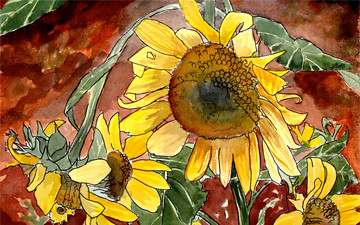Sunflowers (Helianthus annuus) are annual plants native to the Americas, that possess a large inflorescence (flowering head)
What is usually called the flower is actually a head (formally composite flower) of numerous florets (small flowers) crowded together. The outer florets are the sterile ray florets and can be yellow, maroon, orange, or other colors. The florets inside the circular head are calleddisc florets, which mature into seeds
The florets within the sunflower’s cluster are arranged in a spiral pattern. Typically each floret is oriented toward the next by approximately the golden angle, 137.5°, producing a pattern of interconnecting spirals where the number of left spirals and the number of right spirals are successive Fibonacci numbers. Typically, there are 34 spirals in one direction and 55 in the other; on a very large sunflower there could be 89 in one direction and 144 in the other.[1][2][3] This pattern produces the most efficient packing of seeds within the flower head.[4][5][6]
Sunflowers most commonly grow to heights between 1.5 and 3.5 m (5–12 ft). Scientific literature reports from 1567, that a 12-m (40 ft), traditional, single-head, sunflower plant was grown in Padua. The same seed lot grew almost 8 m (26 ft) at other times and places (e.g. Madrid). Much more recent feats (past score years) of over 8 m have been achieved in bothNetherlands and Ontario, Canada.
(From Wikipedia, June 12th, 2010)
—
Helianthus annuus is widely distributed, including weedy, cultivated, and escaped plants. It is the only native North American species to become a major agronomic crop. Despite its considerable variability, attempts have failed to produce a widely adopted infraspecific system of classification. Forms with red-colored ray laminae, known from cultivation and occasionally seen escaped, trace their ancestry to a single original mutant plant. It hybridizes with many of the other annual species.
(From EOL via Flora of North America , June 12th, 2010)
—
– – –




